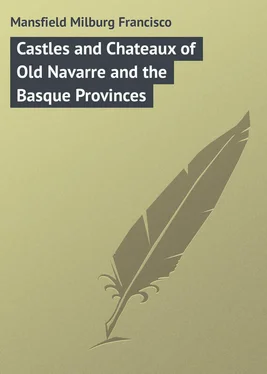Milburg Mansfield - Castles and Chateaux of Old Navarre and the Basque Provinces
Здесь есть возможность читать онлайн «Milburg Mansfield - Castles and Chateaux of Old Navarre and the Basque Provinces» — ознакомительный отрывок электронной книги совершенно бесплатно, а после прочтения отрывка купить полную версию. В некоторых случаях можно слушать аудио, скачать через торрент в формате fb2 и присутствует краткое содержание. ISBN: , Жанр: foreign_prose, на английском языке. Описание произведения, (предисловие) а так же отзывы посетителей доступны на портале библиотеки ЛибКат.
- Название:Castles and Chateaux of Old Navarre and the Basque Provinces
- Автор:
- Жанр:
- Год:неизвестен
- ISBN:http://www.gutenberg.org/ebooks/43609
- Рейтинг книги:4 / 5. Голосов: 1
-
Избранное:Добавить в избранное
- Отзывы:
-
Ваша оценка:
- 80
- 1
- 2
- 3
- 4
- 5
Castles and Chateaux of Old Navarre and the Basque Provinces: краткое содержание, описание и аннотация
Предлагаем к чтению аннотацию, описание, краткое содержание или предисловие (зависит от того, что написал сам автор книги «Castles and Chateaux of Old Navarre and the Basque Provinces»). Если вы не нашли необходимую информацию о книге — напишите в комментариях, мы постараемся отыскать её.
Castles and Chateaux of Old Navarre and the Basque Provinces — читать онлайн ознакомительный отрывок
Ниже представлен текст книги, разбитый по страницам. Система сохранения места последней прочитанной страницы, позволяет с удобством читать онлайн бесплатно книгу «Castles and Chateaux of Old Navarre and the Basque Provinces», без необходимости каждый раз заново искать на чём Вы остановились. Поставьте закладку, и сможете в любой момент перейти на страницу, на которой закончили чтение.
Интервал:
Закладка:
The ville d’eaux , or watering-places, of the Pyrenees date from prehistoric times. At Ax-les-Thermes there has recently been discovered a tank buried under three metres of alluvial soil, and dating from the bronze age.
Old maps of these parts show that the baths and waters of the region were widely known in mediæval times. It was not, however, until the reign of Louis XV that the “stations” took on that popular development brought about by the sovereigns and their courts who frequented them.
Not all of these can be indicated or described here but the accompanying map indicates them and their locations plainly enough.
Nearly every malady, real or imaginary (and there have been many imaginary ones here, that have undergone a cure), can be benefited by the waters of the Pyrenees. Only a specialist could prescribe though.
In point of popularity as resorts the baths and springs of the Pyrenees rank about as follows: Eaux-Bonnes, Eaux-Chaudes, Cauterets, St. Sauveur, Barèges, Bagnères de Bigorre, Luchon, Salies de Béarn, Ussat, Ax-les-Thermes, Vernet and Amélie les Bains.
Whatever the efficacy of their waters may be, one and all may be classed as resorts where “all the attractions” – as the posters announce – of similar places elsewhere may be found, – great and expensive hotels, tea shops, theatres, golf, tennis and “the game.” If the waters don’t cure, one is sure to have been amused, if not edified. The watering-places of the Pyrenees may not possess establishments or bath houses as grand or notorious as those of Vichy, Aix, or Homburg, and their attendant amusements of sport and high stakes and cards may not be the chief reason they are patronized, but all the same they are very popular little resorts, with as charming settings and delightful surroundings as any known.
At Eaux-Bonnes there are four famous springs, and at Eaux-Chaudes are six of diverse temperatures, all of them exceedingly efficacious “cures” for rheumatism. At Cambo – a new-found retreat for French painters and literary folk – are two sources , one sulphurous and the other ferruginous. Mostly the waters of Cambo are drunk; for bathing purposes they are always heated. Napoleon first set the pace at Cambo, but its fame was a long while becoming widespread. In 1808 the emperor proposed to erect a military hospital here, and one hundred and fifty thousand francs were actually appropriated for it, but the fall of the Empire ended that hope as it did many others. In the commune of Salies is a source , a fontaine , which gives a considerable supply of salt to be obtained through evaporation; also in the mountains neighbouring upon Saint-Jean-Pied-de-Port, and in the Arrondissement of Mauléon, are still other springs from which the extraction of salt is a profitable industry.
In the borders of the blue Gave de Pau, in full view of the extended horizon on one side and the lowland plain on the other, one appreciates the characteristics of the Pyrenees at their very best.
One recalls the gentle hills and vales of the Ile de France, the rude, granite slopes of Bretagne, the sublime peaks of the Savoian Alps, and all the rest of the topographic tableau of “la belle France,” but nothing seen before – nor to be seen later – excels the Pyrenees region for infinite variety. It is truly remarkable, from the grandeur of its sky-line to the winsomeness and softness of its valleys, peopled everywhere (always excepting the alien importations of the resorts) with a reminiscent civilization of the past, with little or no care for the super-refinements of more populous and progressive regions. The Pyrenees, as a whole, are still unspoiled for the serious-minded traveller. This is more than can be said of the Swiss Alps, the French Riviera, the German Rhine, or the byways of merry England.
CHAPTER IV
THE PYRENEES – THEIR HISTORY AND PEOPLES
IT may be a question as to who discovered the Pyrenees, but Louis XIV was the first exploiter thereof – writing in a literal sense – when he made the famous remark “ Il y a des Pyrénées .” Before that, and to a certain extent even to-day, they may well be called the “ Pyrénées inconnues ,” a terra incognita , as the old maps marked the great desert wastes of mid-Africa. The population of the entire region known as the Pyrénées Françaises is as varied as any conglomerate population to be found elsewhere in France in an area of something less than six hundred kilometres.
The Pyrenees were ever a frontier battle-ground. At the commencement of the eleventh century things began to shape themselves north of the mountain chain, and modern France, through the féodalité , began to grow into a well-defined entity.
Charles Martel it was, as much as any other, who made all this possible, and indeed he began it when he broke the Saracen power which had over-run all Spain and penetrated via the Pyrenean gateways into Gaul.
The Iberians who flooded southern Gaul, and even went so far afield as Ireland, came from the southwestern peninsula through the passes of the Pyrenees. They were of a southern race, in marked distinction to the Franks and Gauls. Settling south of the Garonne they became known in succeeding generations as Aquitains and spoke a local patois , different even from that of the Basques whom they somewhat resembled. The Vascons, or Gascons, were descendants of this same race, though perhaps developed through a mixture of other races.
Amidst the succession of diverse dominations, one race alone came through the mill whole, unscathed and independent. These were the Basques who occupied that region best defined to-day as lying around either side of the extreme western frontier of France and Spain.
A French savant’s opinion of the status of this unique province and its people tells the story better than any improvisation that can be made. A certain M. Garat wrote in the mid-nineteenth century as follows: —
“Well sheltered in the gorges of the Pyrenees, where the Gauls, the Francs and the Saracens had never attacked their liberties, the Basques have escaped any profound judgments of that race of historians and philosophers which have dissected most of the other peoples of Europe. Rome even dared not attempt to throttle the Basques and merge them into her absorbing civilization. All around them their neighbours have changed twenty times their speech, their customs and their laws, but the Basques still show their original characters and physiognomies, scarcely dimmed by the progress of the ages.”
Certainly they are as proud and noble a race as one remarks in a round of European travel.
A Basque will always tell you if you ask him as to whether he is French or Spanish: “ Je ne suis pas Français, je suis Basque; je ne suis Espagnol, je suis Basque; ou, – tout simplement, je suis homme. ”
This is as one would expect to find it, but it is possible to come across an alien even in the country of the Basque. On interrogating a smiling peasant driving a yoke of cream-coloured oxen, he replied: “ Mais je ne suis pas Basque; je suis Périgourdin – born at Badefols, just by the old château of Bertrand de Born the troubadour.”
One may be pardoned for a reference to the cagots of the Basque country, a despised race of people not unlike the cretins of the Alps. As Littré defines them they are distinctly a “people of the Pyrenees.” The race, as a numerous body, practically is extinct to-day. They lived in poor, mean cabins, far from the towns and under the protection of a seigneurial château or abbey. All intercourse with their neighbours was forbidden, and at church they occupied a space apart, had a special holy water font, and when served with blessed bread it was thrown at them as if they were dogs, and not offered graciously.
Читать дальшеИнтервал:
Закладка:
Похожие книги на «Castles and Chateaux of Old Navarre and the Basque Provinces»
Представляем Вашему вниманию похожие книги на «Castles and Chateaux of Old Navarre and the Basque Provinces» списком для выбора. Мы отобрали схожую по названию и смыслу литературу в надежде предоставить читателям больше вариантов отыскать новые, интересные, ещё непрочитанные произведения.
Обсуждение, отзывы о книге «Castles and Chateaux of Old Navarre and the Basque Provinces» и просто собственные мнения читателей. Оставьте ваши комментарии, напишите, что Вы думаете о произведении, его смысле или главных героях. Укажите что конкретно понравилось, а что нет, и почему Вы так считаете.












